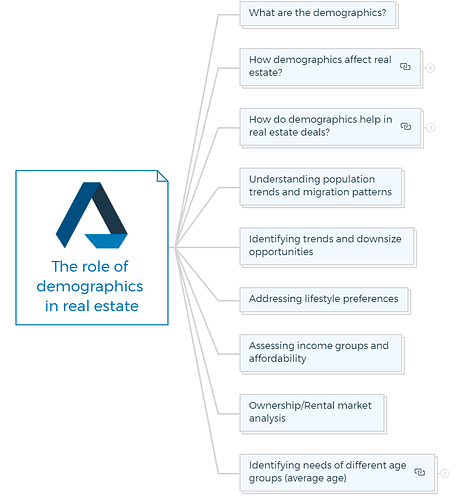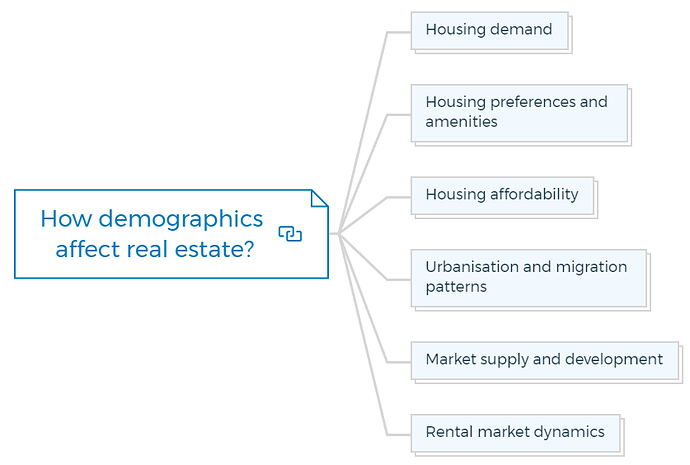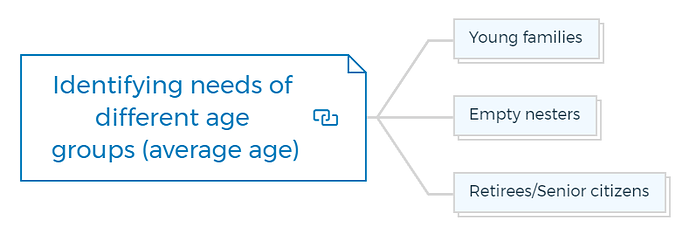Demographics in real estate
Demographics provide valuable insights into the population composition, trends, preferences, and economic factors that shape a given location.
By analysing demographic data, real estate professionals can gain a deeper understanding of the market, identify potential opportunities, and tailor their developments to meet the needs of specific target groups.
What are the demographics?
Demographics are statistical data that includes age, gender, income, education, occupation, and household size. It quantifies an area’s demographics.
In the context of real estate, demographics are highly relevant as they offer valuable insights into the potential market for properties and inform decision-making processes.
You are missing out if you haven’t yet subscribed to our YouTube channel.
How demographics affect real estate?
Demographics significantly affect the real estate market:
Housing demand
Population size, age distribution, and household composition affect housing demand. An increasing population or more young individuals joining the housing market can enhance residential property demand.
Changes in household sizes or multi-generational living can affect demand for larger homes or buildings appropriate for extended families.
Housing preferences and amenities
Demographics influence housing preferences and amenities. Younger generations value metropolitan centres, public transit, and recreational facilities.
Schools and parks may attract families with children. Property developers and investors must understand these inclinations to suit demographic needs.
Housing affordability
Income and affordability affect real estate. Demographics reveal income distribution and affordability issues.
Lower-income communities may need inexpensive homes, whereas higher-income areas may want luxury buildings. To match buyer or renter purchasing power, real estate professionals must examine these affordability criteria.
Urbanisation and migration patterns
Urbanisation and migration trends affect population distribution and real estate demand. Urbanisation increases property demand in cities, while rural areas may expand slowly.
Migration, whether for work, lifestyle, or other reasons, can change housing demand in some areas.
Market supply and development
Demographics affect real estate development and market supply. Demographic data helps developers find markets with strong demand for various property kinds.
Population growth and demographic changes influence real estate investment decisions.
Rental market dynamics
Demographics affect rental markets. Household composition, lifestyle preferences, and affordability might affect rental supply and demand.
An increase in young individuals delaying homeownership may raise rental property demand, while a university town’s student population can affect student housing demand.
How do demographics help in real estate deals?
Using and analysing demographics is crucial for all your property development and investment deals. You need to determine several things, such as:
- The population and future growth of the area.
- The age group of various households
- Most importantly: Does the suburb mainly consist of owner-occupied properties, or is it investor-driven?
Time to walk away
- If, during your due diligence, you find that the suburb consists mainly of investment properties, that is, not a lot of owners live there themselves, stay clear! This has happened many times with mining towns.
- If, for some reason, you see a decline in population in a suburb over the past years, find out the reason why before you invest in that suburb.
With the help of demographics, property developers and investors may make informed decisions. Here are some ways in which demographics help in real estate deals:
- Targeted marketing
- Location selection
- Pricing and affordability
- Risk assessment
- Demand analysis
- Long-term planning
Understanding population trends and migration patterns
Demographics provide critical insights into population trends and migration patterns in real estate. Demographic data helps professionals understand population movement.
This analysis helps explain why people relocate to or leave a suburb. Real estate decisions require understanding these patterns.
Identifying trends and downsize opportunities
Demographics show critical real estate trends like the downsizing phenomenon. Professionals can spot downsizing patterns by reviewing demographic data.
This information indicates that downsizers may have additional funds available after selling their previous properties. The age group of downsizers also influences the design and development of properties to cater to their specific needs.
Addressing lifestyle preferences
Demographics influence lifestyle changes. Many Melbourne residents have downsized in Caulfield and moved to Chelsea. Lifestyle change motivates this migration.
Although Caulfield no longer has the necessary amenities, the land is pricey. Thus, Caulfield residents sell their homes and move to more suitable neighbourhoods. Understanding demographic shifts helps find opportunities and meet changing demands.
Assessing income groups and affordability
Demographic data helps determine affordability by showing income groups in an area. Real estate developments must include average household income.
High-end houses in an area with an average income of $4,000 per month would likely sell poorly. Professionals can identify target market income levels by analysing demographics, ensuring that properties produced match their financial capabilities.
Ownership/Rental market analysis
Demographics distinguish owner-occupied from renter-occupied places. Rental yields and market dynamics depend on a location’s homeowner-renter ratio.
Owner-occupied areas have lower rental returns because residents prioritise their personal housing needs over investment units. Conversely, renter-heavy locations may be desirable to property investors. Real estate agents can learn from the causes of higher rental occupancy.
Identifying needs of different age groups (average age)
Real estate experts must identify age groups based on average age to understand potential buyers’ and renters’ needs. Real estate agents can boost property sales by meeting these needs.
For example -
A real estate developer wants to establish a multi-age community. The developer can learn about potential buyers’ age-specific wants and preferences by analysing the area’s average age demographics. This scenario highlights the demographics:
Young families
If the average age shows a lot of young families, the developer can emphasise family-friendly amenities and spacious homes with numerous bedrooms and child-friendly features. This demographic needs schools, parks, and recreational amenities nearby.
Empty nesters
If the average age implies more empty nesters, the developer can plan properties for downsizing.
Property developers may develop low-maintenance homes with single-level layouts, smaller yards, and age-in-place amenities like grab bars and accessible designs. This age group also values community leisure and social events.
Retirees/Senior citizens
If the average age shows a large number of retirees, the developer can focus on age-restricted communities or retirement villages.
These communities may offer healthcare, fitness, social activities, and 24/7 security for elders. To satisfy this population, properties must be accessible and mobile.
Based on average age demographics, real estate developers can adjust their marketing, design, and facilities to their intended population. This focused strategy boosts buyer and renter interest and resident satisfaction.
It also lets developers match their investments to market needs, increasing marketability and ROI.
Above all, how do you collect demographic data? Worry not; jump to my next video, where I will teach you to collect and use demographic data in Australia.
Test Your Knowledge
Practical Exercise: Understanding and Utilizing Demographic Data in Real Estate Development
Objective:
This assignment is designed to help students gain practical experience in collecting, understanding, and using demographic data for property development in Australia. Students will explore various data sources, analyze demographic indicators, and apply this knowledge to make informed real estate decisions.
Instructions:
Review Materials
Begin by watching the attached video on navigating websites for real estate demographic data in Australia. Read through the provided article to understand the importance of demographic data in real estate.
Research Task:
- To Do: List all the sources mentioned for collecting demographic data in Australia, including any websites, government agencies, and private organizations.
- Question: Why is demographic data important for real estate professionals?
Data Collection:
- To Do: Visit the Australian Bureau of Statistics (ABS) website. Find and download data on the population distribution by age and income levels in two different regions of your choice.
- Question: What challenges did you face while collecting this data?
Data Analysis:
- To Do: Analyze the downloaded data to identify which region has a higher median income and a younger population. Create a brief report summarizing your findings, including graphs or tables to support your analysis.
- Research Question: How can the differences in demographic data between these regions influence real estate development strategies?
Practical Application:
- To Do: Based on your analysis, propose a type of real estate development (e.g., residential, commercial, mixed-use) that would be suitable for each region. Justify your choices based on the demographic data.
- Research Question: How do demographics affect property pricing and investment decisions in the real estate market?
Ethical Considerations:
- To Do: Reflect on the ethical considerations and limitations of using demographic data in real estate. Write a short essay discussing privacy concerns, data accuracy, and the risk of making generalizations.
- Question: How can real estate professionals mitigate the risks associated with demographic data collection and analysis?
Deliverables:
- A compiled list of sources for demographic data in Australia.
- A report on the population distribution by age and income levels in two different regions, including your analysis and findings.
- A proposal for real estate development in each region, supported by demographic data.
- An essay on the ethical considerations of using demographic data in real estate.
Assessment Criteria:
- Understanding and correct identification of data sources.
- Accuracy and depth of data analysis.
- Logical reasoning in real estate development proposals.
- Insightfulness and thoughtfulness in the discussion of ethical considerations.
Submission Guidelines
- Submit your assignment as a single PDF document through comments or mail. Ensure that your report is clear, well-organized, and includes all necessary citations for the data and resources used.







